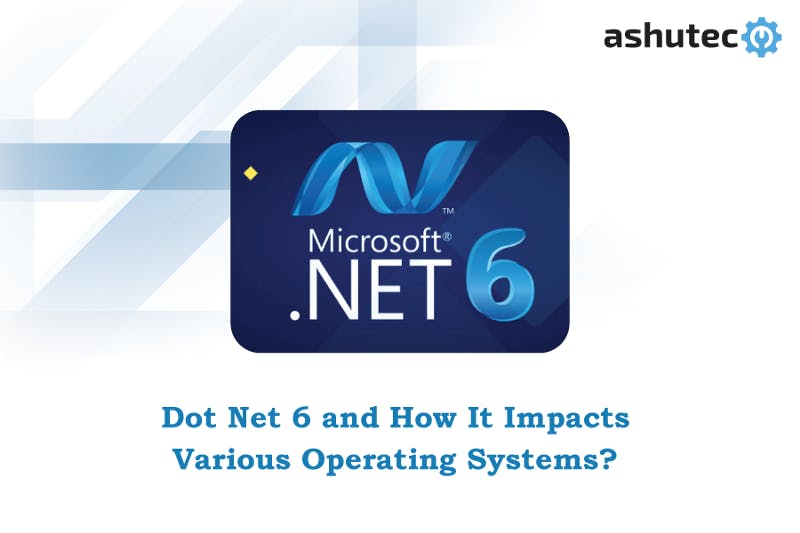Let’s Connect!
Work can be a fun when we know and understand each other well. Let's start conversation to new beginning
+91 63542 35108
To discuss what we can do for you Give us a Call
connect@ashutec.com
Tell us about your next project Write to us

It’s been around 7 to 8 months since we witnessed the launch of version 6 of Microsoft Dot Net. I have already delved deeper into what new features and functionalities were included in that particular version in the below post.
Also, I have compared .Net 6 performance with the .Net 5 version and stated how the 6th edition has changed the game for development.
Today, I’ll be explaining the impact dot net 6 had on various operating systems. The latest edition allows developers to select from an array of frameworks and technologies to create unique solutions.
Microsoft has promised to provide 3 years of support for the .Net 6 compared to just 1.5 years for .Net 5. Moreover, the .Net 6 comes with many feature enhancements along with C# and Visual Studio improvement.
But the only thing we need to see is how this new version will impact different operating systems? So, let’s get into it:
Just after the release of the 6th version of dot net on 8th Nov 2021, the Microsoft team recommended migrating to it immediately. Framework migration was possible for apps developed using Net Core 3.1 or .Net 5.
Among the number of updates, the good thing that came out of dot net 6 was that it was the first instance where a .Net framework will be supported for macOS Silicon in addition to the Windows ARM64. Here’s a brief on what features are included in .Net 6:
Dot Net 6 also supports C# 9.0 and F# 5.0 along with Visual Basic 16 with additional languages expected this year. The installation procedure includes a runtime for new console and server programs, windows desktop applications, and ASP.Net Core web application runtime.
The current version of the .Net supports Microsoft Windows, Linux, and Mac operating systems as is the x64 architecture and ARM of Windows and Linux are supported.
Another thing with the .Net 6 is the .Net cross-platform capabilities and unification of all .Net frameworks. This makes the Xamarin implementation a critical component here. Now you can target different operating systems such as macOS, Android, and iOS with the same code if multi-platform app UI is used.
All these are enough reasons to use .Net 6, still here are a few more to use the current and future .Net versions:
Let’s have a look at some advantages of using .Net 6 for multiple operating systems:
New namespace syntax is introduced in the C# 10 along with other features such as Hot Reload, Minimal Web APIs, and using global as well as implicit variables. All these help improve the performance of .Net 6.
Developers who follow this strategy face a low number of challenges which further simplifies the development process.
Due to the newer framework, programs will consume less memory and power than they did in the previous version. This has resulted in benefits such as speed improvement, enhanced serialization, casting, and file I/O management.
Furthermore, when moving an existing .Net app to a new framework, you won’t experience performance degradation. Also, the interface casting has been improved too.
Dot net 6 offers new and completely redesigned project templates that are easier to grasp and develop. They will provide programmers with some new functionality but they won’t be forced to implement them.
Developers can gain knowledge from various facets of the Dot net 6 ecosystem and benefit from participating in it. For instance, Hot Reload is frequently employed through the development process. It allows developers to complete the entire build cycle by enabling code changes to reflect in a running code.
The openness of the .Net 6’s development process is one of the most exciting characteristics. Experiments are going on by Microsoft to test the new approach to open design .Net 6.
Another thing with .Net 6 is the consolidation and enhancement enable the platform to support web, cloud, IoT, mobile, and desktop development. Also, the multi-platform app UI is one of the most exciting components.
Meanwhile, C# and XAML can be used for native mobile app and desktop software development. Using the .Net MAUI, developers can design world-class Android, iOS, iPadOS, macOS, and other windows apps.
Since everything is under one roof, developing or modifying new apps becomes effortless which makes .Net 6 an OS agnostic.
As we have seen, the performance enhancement in .Net 6 has proven to be a game-changer and welcome addition to the .Net ecosystem. It’s projected to become the primary .Net development platform. This makes a clear indication of where .Net is going and how it will continue to impact multiple platforms or OS development.

